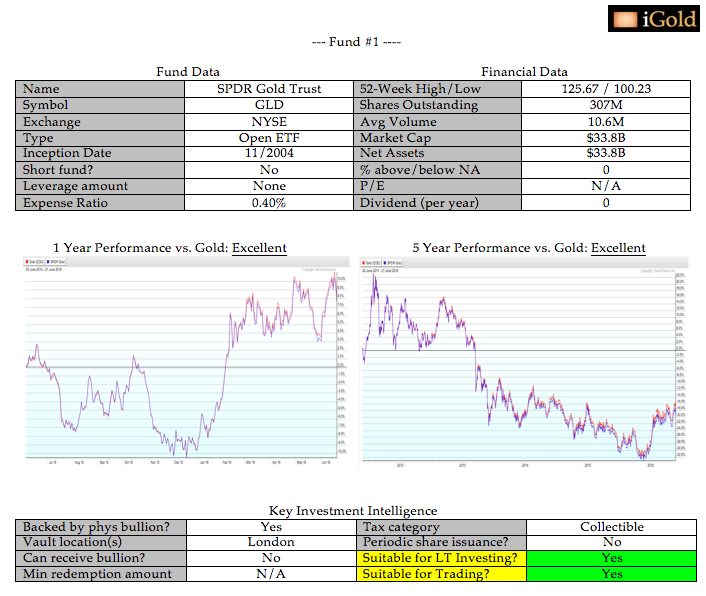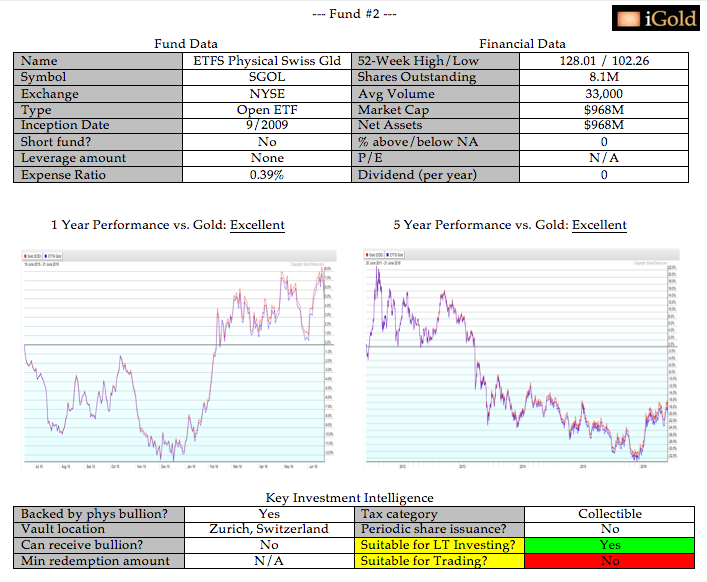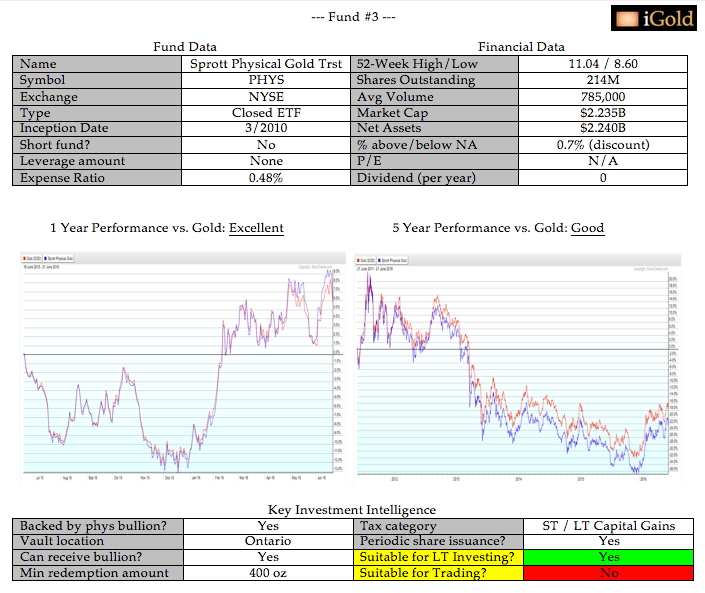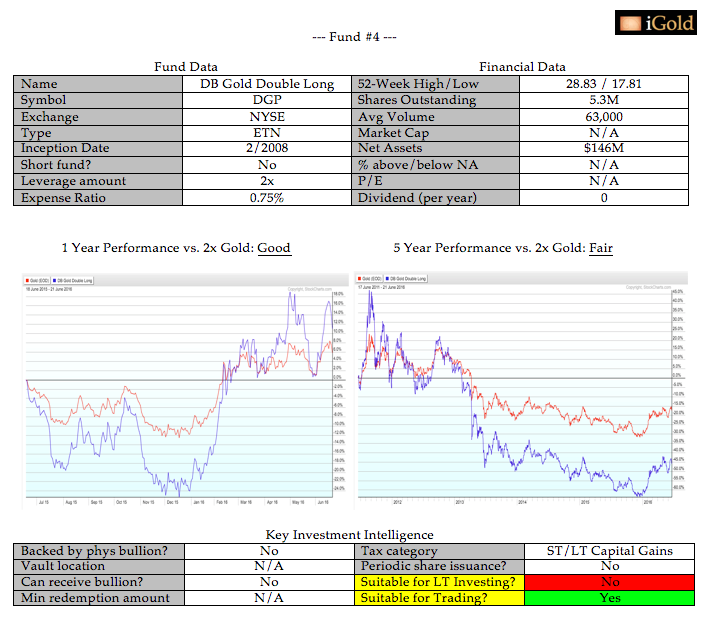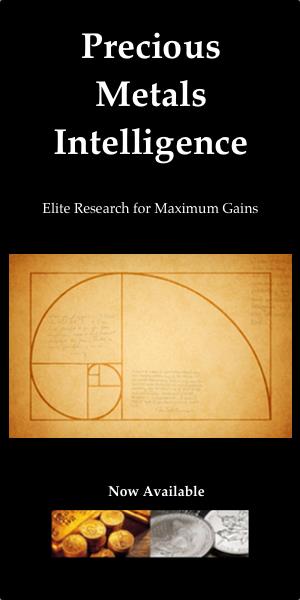Understanding Gold And Silver ETFs (Part II)
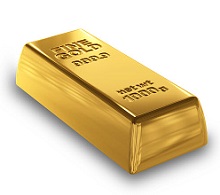
Last week we examined the history of gold ETFs, the types of funds available, and an overview of tax laws surrounding the precious metals.
Today, we will continue by looking at several top fund recommendations for those who seek to participate in the precious metals market without having to take physical possession of the actual metal. This can be convenient for those who live in unsafe jurisdictions, who are traveling, or who wish to capitalize on beneficial tax treatments for some of the funds.
In the fund reviews below, you will see a Tax Category under the Key Investment Intelligence section (note: this applies for US investors only). You will see one of two categories listed:
Collectible - This fund is taxed the same way as gold bullion, i.e. at the 28% rate, regardless of how long the fund is held. Typically, this will be the Open ETFs, those funds that directly invest in precious metals and aim to closely track the metal's price on a daily basis.
ST / LT Capital Gains - This fund is taxed in the same way as most regular stocks; that is, it is eligible for taxation at the 15% long-term capital gains rate if it is held for over one year, with higher rates if it is held for under one year. Typically, this will be the Closed ETFs, those funds that own a set amount of precious metals and do not directly track the metal's price on a daily basis. Additionally, ETNs usually fall in this category.
Which type of fund you choose will depend on your unique financial situation, and whether or not you intend to hold the fund as a long-term investment or a short-term trade.
Some Fund Recommendations
Investing in precious metals is an important financial decision, and it is even more important to execute that decision properly. Although no two individuals will have exactly the same financial goals or risk tolerance, we have tried to narrow the focus in this article to two main groups:
- Long-term investors (over 1 year)
- Short/intermediate-term traders (under 1 year)
In each fund review, there is suitability analysis for each of these groups of investors. This analysis takes into consideration all of the data we have available to us and provides a quick reference point with which to evaluate each fund.
It should be an exciting time to be in the gold and silver markets over the next few years. Best success now and in the future.
SPDR Gold Trust
Summary Analysis
As the largest precious metal ETF, GLD is the most liquid bullion fund in the market. It tracks the underlying price of gold extremely well. Gold is stored in allocated and unallocated form in London. Because of these aspects, it is suitable both for short-term trading and long-term investment.
Management fees are higher than the comparable IAU fund. Individual investors may save money in the long run with IAU. Larger investors may favor the higher liquidity in GLD.
Note that for US investors, this fund will be taxed at a 28% 'collectible' tax rate even on long-term holdings, the same as they would for gold bullion. This rate is higher than the 15% long-term capital gains tax seen in some other funds.
The liquidity and tracking record of GLD combine to make it the #1 fund for short or intermediate-term gold traders.
ETFS Physical Swiss GLD
Summary Analysis
SGOL holds all its gold in allocated form, in Zurich, Switzerland - that is its claim to fame. So, theoretically, its gold is more secure than that of GLD. Its expense ratio is nearly identical to GLD, as is its ability to track the price of gold. Thus, for an individual investor with a long-term time horizon, SGOL could be superior to GLD.
Note that liquidity can be low, so this fund would not be suitable for large investors trying to move large amounts of capital on a regular basis. Because of this lower liquidity, it is also not suitable for trading.
For individual investors who are comfortable with GLD's expense structure and tax category but who would rather have their bullion held in allocated form in politically-safe Switzerland, SGOL fits the bill.
Sprott Physical Gold Trust
Summary Analysis
Sprott Inc.'s PHYS has some unique aspects in the gold ETF market. First, because it is a closed-end ETF, it is not taxed as a 'collectible' as are most other gold funds. Rather, if its shares are held over a year, it is possible to qualify the gains as long-term capital gains, similar to any other long-term stock investment.
In addition, the fund may trade at a premium or a discount to its NAV. Typically the fund will trade at a premium to its NAV during bull markets, yet trade at a discount to its NAV during bear markets, due to investor sentiment.
Investors should be aware that the fund will periodically issue new shares when the premium to NAV becomes too high. These new issuances are always used to purchase new gold bullion. So while these issuances are not dilutive to existing shareholders, they can temporarily impact the premium to NAV, which can result in an unexpected drop in price per share in the short term. Long-term investors would do well either to buy immediately after a new issuance (when the premium is typically lower), and/or to sell well after a new share issuance (when the premium may be higher again).
PHYS is one of only two funds that allow individual investors to redeem shares for physical delivery of gold. The minimum requirement for redemption is one LBMA (London Bullion Market Association, the international clearinghouse for gold bullion) good-delivery bar, which range in size from 350 to 450 ounces of gold. So, assuming an individual were to redeem shares for an average-sized 400-ounce bar, the total dollar amount (at $1,250 gold) would be roughly $500,000. Most individuals will never use this feature, but it is important to some larger investors, and because of this, PHYS can command a premium in the market.
The shares are not nearly as liquid as the larger GLD or IAU funds, and because of the NAV discount possibility, this fund is not suited for short-term trading. For those looking to take advantage of the beneficial tax treatment or the security of knowing their gold is redeemable, PHYS makes a lot of sense as a long-term way to securely hold gold outside of the US.
The strong tracking record, a possibility of premium to NAV, eligibility for long-term capital gains treatment, and physical delivery option makes PHYS a #1 gold fund for long-term investors.
DB Gold Double Long
Summary Analysis
DGP aims to achieve twice the daily performance of gold bullion. It will perform especially well in a bull market without significant pullbacks. As an ETN, DGP benefits from the capital gains structure of a stock.
It is not suitable for long-term investment due to decay effect and high management fees.
A simple mathematical example will show the decay effect: say gold bullion moves from $1,000 to $1,100 per ounce, and then drops back to $1,000 per ounce, over the course of two days (unlikely to happen, but the example works the same for smaller dollar amounts). The net result from an investment in gold bullion would be 0%.
Now let us examine the DGP fund. As gold moves from $1,000 to $1,100 (a 10% gain), DGP would gain 20%, reaching $1,200. So far so good. Yet now when gold falls back from $1,100 to $1,000 (a 9.1% loss), DGP would record double that loss, or 18.2%. An 18.2% loss from $1,200 equals 981.81. Thus, we can see that even though gold had zero net gain or loss, GDP recorded an overall loss of almost 1.8%.
This decay effect is clear to see on the relative performance charts above.
The bottom line for leveraged funds is that they can be useful for individual investors who are looking to capture leverage to the price of gold over the very short term. A strong move over a few days to a few months is all that can realistically be captured. Over the long term, especially when the markets are volatile, these funds can be hazardous to your financial health. We have seen investors wrongly assume that these funds would double the underlying price of gold over a certain time period, and be right on the direction of the metal, yet end of taking a loss on these funds.
Over the long-run, if an investor is looking to capture leverage to the price of gold, a basket of high-quality gold mining equities would better serve this purpose, which may far outperform the price of gold itself in a rising gold price environment.
********
Free Gold-Eagle Newsletter!
- Fresh weekly insights on gold, precious metals, and the economy
- Leading authors from around the world
- Always free
- Stay informed!

